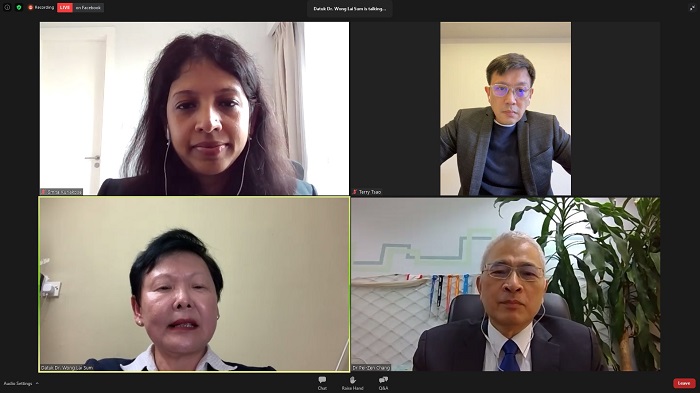National E&E Forum 2020: Tech centres, collaboration and an R&D-focused ecosystem is vital in creating global champions
By Tan Jee Yee December 3, 2020
- The government is the most important stakeholder in figuring out key strategies
- Taiwan’s ITRI is a strong example of how tech centres can bridge academia and industries

The global Electrical & Electronics (E&E) industry is a competitive landscape – one that is now made more complex by the Covid-19 pandemic.
It’s a vital industry in Malaysia. After all, E&E products make up the largest exports in the country. According to the Malaysia External Trade Development Corporation (MATRADE), in January to October 2020, the sector contributed 39.4% of total exports in Malaysia.
There is a need, then, for the industry to remain competitive and relevant post-pandemic. The question now, of course, is how to elevate that.
The answer, it seems, is about collaboration. That’s one of the major takeaways of a panel discussion titled “Role of Technology Centres in Creating Global Champions”, which is a part of Malaysia’s National E&E Forum 2020 held on Nov 30.
“Success in the increasingly global and more competitive E&E industry relies on how we collectively leverage different stakeholders. That, I feel, is the key to success for every country,” says SEMI’s president of Taiwan and global chief marketing officer Terry Tsao.
The most important stakeholder, Tsao says, is the government. “The government has to figure out what are the key strategies, and the competitiveness of the E&E industry. What is your base foundation? What are the future opportunities? As a country, this is what you have to do.”
Beyond that, it’s crucial for governments to have a research grant or fund to support the industry’s foundation – something which Tsao says is vital in the success of global E&E giants like the US, Taiwan and China.
This is the groundwork that needs to be laid. On top would be a thriving E&E ecosystem, which includes universities and research institutes. Tsao mentions the importance of incubating startups and big companies to collaborate and work together. “That will build an ecosystem that will become the centre of technology development,” he explains.
Collaboration between all these stakeholders is important because, as Tsao says, the cost of E&E development and innovation has become expensive, and no entity can do it alone. Collaboration also means leveraging global resources, such as partnering with global research institutions to create joint programs with local academia and universities.
Governments also need to consider inviting global consortiums or associations to bring in more of their members into the Southeast Asian region, so that the ecosystem can be built up.
Nexus between industry research and academia
Meanwhile, Panellist Smita Kuriakose, senior economist of World Bank Group, notes that the pandemic has accelerated digitisation into something that is no longer a medium-long term agenda, but a short term one.
For Malaysia, being globally integrated into the E&E industry, means that keeping a competitive edge is pivotal, especially for SMEs in the sector. E&E requires a lot of research and development (R&D) as well as capital investment – something the industry’s ecosystem will need to be able to address.
“The role of the state is to provide the ecosystem to enable firms to actually adopt technology, undertake R&D, as well as create an atmosphere that continuously reskills and upskill their workers,” she says.
The other very important aspect, Smita adds, is the nexus between industry research and academia. She believes that research institutions need to instill values of publishing industry-relevant research and the commercialisation of this research. This is where incentives come in. But while they exist on paper, Smita observes that the implementation of these incentives is not adequate.
Talent is also something the industry would need to address. This comes back to the role of the government in ensuring that higher-level education and curriculum is agile enough to keep E&E talents adopting to new trends.
Smita ultimately echoes Tsao’s points, in that effective public-private partnership – this dialogue between the public and private sector – is key to ensuring an ecosystem that is not only conducive, but also in how policymaking receives feedback from all stakeholders.
There is clear example that this works. Look no further than the Malaysian state of Penang, says Smita. Here, skills development is touted as an example of a successful public-private partnership, in which the E&E industry is very vital in steering the curricular of the institutions.
The ITRI example
For a better case study, we can, of course, look into one of the most successful E&E industries in the world: Taiwan. Dr Pei-Zen Chang, executive vice president of the Industrial Technology Research Institute (ITRI) in Taiwan, shares how ITRI helped grow the industry – and how it encompasses the aspects discussed by the prior two panellists.
Founded in 1973, ITRI played a vital role in transforming Taiwan’s industry from labour-intensive into an innovation-driven one. Beyond providing the foundation for a slate of innovations, ITRI also helped foster new industries in the country, as well as having incubated 270 companies since inception.
As Chang notes, ITRI bridges the gap between industry and academia. For the most part, academic research may not necessary reach industry application.
ITRI’s Exploratory Research Program and Technology Development Program (TDP) for Research Institutes, however, can help move this research from a basic research into an applied research and subsequently technology development and prototype verification. The industry will then be able to adopt this and bring it into production after further R&D.
There are other significant ways ITRI grows the E&E industry in Taiwan. For one, ITRI covers six major research fields, making it more comprehensive. Beyond R&D and technology transfer, it also provides various types of industry consulting services.
ITRI may be instrumental to Taiwan’s industries, but it’s only one (albeit significant) cog in a wheel that makes up a robust E&E ecosystem. Other stakeholders are there to fill in certain gaps.
For instance, there is concern that SMEs in the industry may not have the finances necessary to invest in new technology, resources and research. In Taiwan, the Small and Medium Enterprise Administration (SMEA), which is part of the country’s Ministry of Economic Affairs (MoEA), has the Small Business Innovation Research Program (SBIR) that provides funding resources for SMEs based on their R&D proposals.
This, Chang says, is aimed at encouraging SMEs to undertake R&D investments. On top of that, the MoEA’s Industrial Development Bureau also has several industry counselling programs, which entrust tech centres to provide counselling services to SMEs.
So yes, ultimately, tech centres play a significant role in developing the E&E industry, but these need to function within a well-oiled and encouraging ecosystem. As Tsao and Smita iterates, the key is collaboration among public and private sectors. With R&D being so vital to innovation, this ecosystem also needs to be one that translates research into commercialisation, Smita stresses.
It takes a village, as they say. In this case, it takes a country.
Related Stories :


